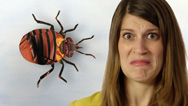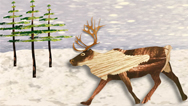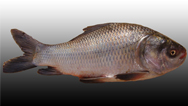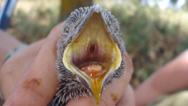Can Bird Poop Make Clouds?
- By Anna Rothschild
- Posted 01.05.17
- NOVA
Bird poop could help clouds form, keeping our planet a little bit cooler. Discover how in this episode of Gross Science.
Transcript
Can Bird Poop Make Clouds?
Posted: January 5, 2017
Do you see a fluffy white cloud in the sky? Depending where you are, it could be made of bird poop—well...kind of.
I’m Anna and this is Gross Science.
To understand how bird poop could make clouds, you first need to know a little something about how clouds form. So, clouds form when water evaporates from ocean, lakes, and other reservoirs, or is released from plants in a process called transpiration. This water is in a gaseous form, called water vapor, and it floats up into the atmosphere. Now, the vapor could just hang out in the air unseen. But in order to become a cloud, the water has to cool and attach itself to something we call a “condensation nucleus.” Dust particles, ice crystals, specks of pollution, and even fungal spores can all serve as “condensation nuclei.” Water molecules glom onto them, becoming water droplets—and when this is repeated over and over again, we can see these droplets in the form of clouds.
So, what does this have to do with bird poop? Well, bird poop is really rich in nitrogen. And we’ve known this for years. Beginning centuries ago, people would actually mine guano—which is a fancy term for the accumulated poop or seabirds or bats—and they’d use it as fertilizer, because nitrogen helps plants grow. But, humans aren’t the only creatures with an affection for guano. Bacteria love it, too.
Bacteria chow down on the guano, and release another nitrogen-based molecule, called ammonia, as a waste product. And given that tens of millions of seabirds spend their summers in the Arctic, bacteria there produce a ton of ammonia—about 40,000 metric tons each year, to be exact.
When the ammonia drifts up into the atmosphere, it reacts with sulfuric acid and water. And when other molecules in the air latch on it becomes a condensation nucleus—adding to the total number of these guys floating around above the Arctic.
Now, you know how clouds can either look bright or dark? Well, that’s due to the size and number of droplets they’re made of. Here are two clouds, each in an environment with the same amount of water vapor in the atmosphere. The bright one is made of a large number of small droplets, while the dark one is made of a small number of large droplets. In the bright cloud, the water’s just divided among more condensation nuclei.
Now, there’s still a lot we don’t understand about how clouds affect climate, but we do know that bright clouds help reflect sunlight away from Earth, which means that they can have a cooling effect on our planet. And that means that all the additional droplets contributed by the ammonia from Arctic bird poop could be helping to keep our planet a little bit cooler. The effects are likely not huge. But as Greg Wentworth, a scientist involved with the study, told me, the birds make a “relatively small, yet smelly, contribution.”
For me, this study brings home the importance of basic research. Both on clouds, but also on seabird biology. Now that that we know bird poop may be part of our climate story, it’s more important than ever for us to study and protect them. So, all you future scientists out there—I hope you’re feeling inspired. And maybe just a little grossed out.
Ew.
Credits
PRODUCTION CREDITS
- Host, Writer, Animator, Editor
- Anna Rothschild
- Camera, Sound
- Janet DeFilippo
- Plucky Little Thing
- Music Provided by APM
- Many thanks to Dr. Greg Wentworth
FOOTAGE AND IMAGES
- Bird Photography Outtakes
- Flickr/Ingrid Taylor
- Monterey a rock with bird+their crap
- Wikimedia Commons/Mrmariokartguy
- Bagged Quano & Trolly
- Wikimedia Commons/J.R. Mann
- Grímsey puffins
- Flickr/Jennifer Boyer
- Guillemots on Bear Island Svalbard Arctic
- Flickr/Gary Bembridge
- Dreierprofil
- Wikimedia Commons/Henning Allmers, halmers@uos.de
SFX
- Cockroaches
-
Freesound/StateAardvark
(used with permission from author) - Squeak Pack/squeak_10
- Freesound/Corsica_S
- Slide Whistle Down 01
- Freesound/joedeshon
- Slide Whistle Up 01
- Freesound/joedeshon
- Wink
- Freesound/bennychico11
- Produced by WGBH for PBS Digital Studios
Sources
Want more info?
(Primary Literature) Contribution of Arctic seabird-colony
ammonia to atmospheric particles and cloud-albedo radiative
effect:
http://go.nature.com/2ftUAOs
Science News article on bird poop and clouds:
http://bit.ly/2ftQ0jb
NASA on bright and dark clouds:
http://go.nasa.gov/2ftUbLK
Related Links
-

Gross Science
Bizarre stories from the slimy, smelly, creepy world of science.
-

The Secret Lives of Reindeer
Meet the real Rudolph, from bloody antlers to super vision.
-

Power From Fish Scales?
What should you do with stinky old fish skins? How about powering your cellphone?
-

Defensive Vomiting
If you're attacked you could run away, fight back... or you could barf.

